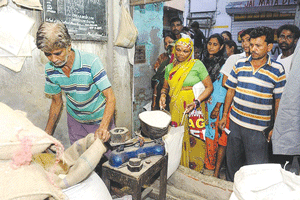BPL RATIONS: The FM has sharply cut allotment for subsidies which include supply of food grain at concessional rates to the poorer classes under the rural employment scheme
By Arvind Pinto
The Union budget for 2022-2023 projects huge dreams dramatized by a mega allocation for building infrastructure. Whether this will materialize is doubtful. Finance Minister Nirmala Sitharaman seems to have focused entirely on the supply side without displaying any concern for the poor and the damned .
OVER the years, the charm and secrecy of Budget Day has dwindled. Neither the TV coverage, nor the next day’s newspapers garner eyeballs, since most people who live dreary lives know that they will find little hope in the finance minister’s pronouncements except for more promises of a fulsome future that for most Indians is a distant dream
What did Finance Minister Nirmala Sitharaman have to offer? If the budget is seen in its entirety, there was precious little for the common man struggling under the weight of inflation and the constant rise of prices. If anything, the prices will continue to rise, since the fiscal deficit is pegged 6.8% This deficit will ensure a further rise in the prices of common items.
BIG PICTURE
BUT let’s first look at the big picture. It is stated that the economy is on track to grow at the rate of 9.2% for the current year; said to be the highest among all the large economies. While most of the developed countries are on a slow track, there was no comparison with our neighbor China, whose economy continues to grow in double digits, despite Covid-19.
The budget, as one critique says, was replete with positive sounding vibes “complementing macro-economic level growth focus with micro-economic level welfare focus” or again, “relying on a virtuous cycle from private capital investment helping to crowd-in private investment.” What does this high-sounding verbiage mean?
If one were to read between the lines, it means that government would rather implement big projects in the hope that some of this largesse would trickle down to the poor and the needy; or again, since private investment is still in a state of covid shock, the government hopes that its spending will spur more private investment. The truth is that private investment is at an all-time low.
BANKS PLAYING SAFE
THIS is seen by the fact that banks aflush with funds, are averse to taking risks by expanding their loan book, preferring a safe alternative by parking their surplus funds with either the RBI or other banks. Thus, the budget believes that government capex and infrastructural spending is sufficient to accelerate the economy.
The Finance Minster has laid out the plan for the Prime Minister’s Ghati Shakti –which according to her would be driven by seven growth engines: roads, railways, airports, ports, mass transport, waterways and logistics infrastructure. Under these broad heads, there are individual plans, for example under roads, what is envisaged is the completion of 25,000 kilometers of national highways in the financial year 2022-23.
Under the head of logistics, there is a vision to allow free flow of data exchange among all mode operators. Under the head railways, a concept of one station one product, or the commencement of 400 new generation Vande Bharat trains. While much of these are visionary, how would they play out on the ground in the coming year would be of importance.
For presently while the country is coming out of the third phase of covid, and thanks to the mass vaccination drive, the fatality rate is low but the fear of the virus has put paid to our economic regeneration. Unemployment in India at 3.5% of the work force, especially among those who have finished their education is something that the country is not able to overcome.
DIGITAL UNIVERSITY
ON the educational front, the emphasis, given our Covid-19 experience is on digital learning. There are plans to start a Digital University with world class facilities. Again, there is nothing concrete in the proposal. What would be the shape and scope of this University? Would a graduate from a digital university finds a job in the market place? How would practical subjects say, chemistry, biology or medicine be taught in such a university? Like many of the proposals in the budget, these are but dreams that would have to be materialized before they could become workable solutions.
There are certain forward-looking proposals: There is a proposal for land record management, an area where corrupt practices and middlemen could be eliminated. The chip-based passport to be introduced would be a forward-looking proposition. While the government is still debating on the issue of crypto-currency, income from the transfer of virtual assets will be taxed.
Over the past few years the income tax department has been able to gather vast data of transactions that its citizens undertake. With the compulsory PAN and Aadhar card insistence for any land, stock, bank or any high value transaction, the tax department is able to identify sources of the income of every tax or non-tax-person. The government has introduced a scheme whereby a person can come forward to declare this income by revising one’s return filed.
All you need to do is to go to the Annual Information Statement site that is available with the Tax Department to find out whether the item of income that you choose not to declare is already known. If so, it would be prudent to revise your returns, lest you be issued a reassessment notice!
With elections around the corner, hopefully this year there was not a significant dole given out to the states where polling is due. Remember last year Goa was given Rs300 crore for its diamond jubilee celebrations, in the knowledge that elections were due in 2022. The budget did not see any such largesse being doled out. The budget while drawing a vision of tomorrow, has little to help people today, burdened with unemployment, rising costs and a dim future!
